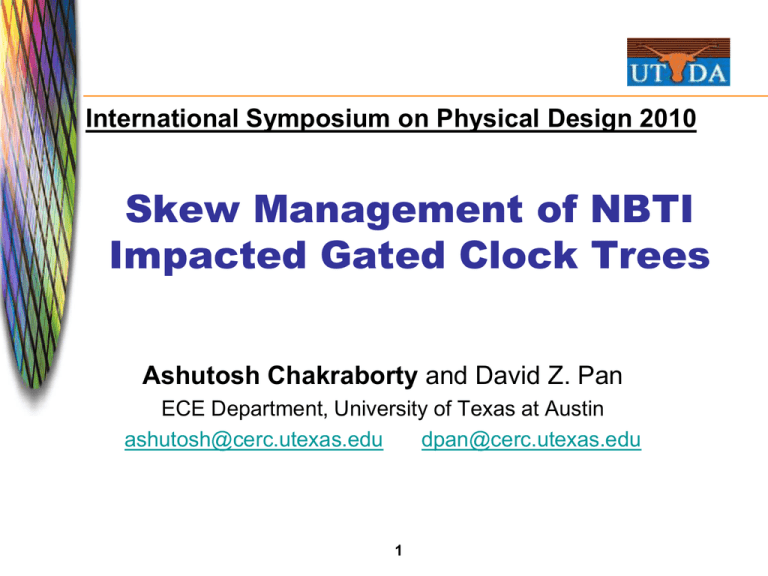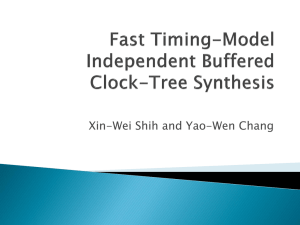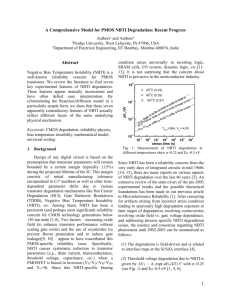Slides
advertisement

International Symposium on Physical Design 2010
Skew Management of NBTI
Impacted Gated Clock Trees
Ashutosh Chakraborty and David Z. Pan
ECE Department, University of Texas at Austin
ashutosh@cerc.utexas.edu
dpan@cerc.utexas.edu
1
Outline
Background: Clock Gating & NBTI Effect
Problem: Skew due to NBTI in gated clock
Previous Works
Proposed Solution
Results
2
Clock Gating
Very popular low power technique
Freeze (“gate”) clock to inactive module
› Needs: Signal informing if a module is inactive
› Needs: Way to use this signal to freeze clock
Inactivity deduced by checking input permutations
› Example: OPCODE for adder? Freeze multiplier clock
› RTL simulation and ON/OFF set manipulation helps
3
Clock Gating (2)
Duration of gating determined by many factors
› Gating aggressiveness, input data statistics
How to stop clock signal?
› Use NAND/NOR/AND/OR gate
› One input: regular clock signal
› Other input: Inactivity/Activity signal
CLK
CLK_OUT
Active?
4
Example Clock Tree
FLOPS
CLK
5
Minimize Clock Gating Elements
40%
FLOPS
CLK
20%
30%
6
Implementation using NANDs
GATE: 40%
FLOPS
CLK
GATE: 20%
GATE: 30%
7
NBTI Effect
Negative Bias Temperature Instability
Occurs when PMOS negatively biased (VGS<0)
Reason:
OXIDE
› VGS<0 causes Si-H breaking
› Need higher VG to invert channel
POLY
Effects:
› ∆VTH = +100mV 10 years
› 30% increase in inverter delay
S
D
[Kumar et. al. DAC 2007]
8
[Alam et. al. 2005
Micro. Reliab.]
NBTI Effect (2)
Proportional to negative bias duration (~tN)
For PMOS in standard cells,
› VGS < 0 VG < VDD Input to cell = logic LOW
› Thus, logic LOW feeding a cell causes NBTI
› Differing LOW probability different degradation
Define SP0 = Probability of signal to be LOW
› Higher SP0 More NBTI Degradation
9
Outline
Background: NBTI & Clock Gating
Problem: Skew due to NBTI in gated clock
Previous Works
Proposed Solution
Results
10
SP0 Difference due to Clock Gating
SP0=50%
SP0=50%
Larger ∆VTH
CLK
SP0=50%
SP0=50%
SP0=35%
GATE: 30%
Lower ∆VTH
Using NAND gate reduces SP0 at output
Using NOR gate increases SP0 at output
In both cases, ∆VTH mismatch will exist!
11
Skew?
Problems due to ∆VTH mismatch?
Clock skew can degrade significantly!
Up to 2.5X increase in skew [Chakraborty et al,
DATE 2009]
› Large variation due to difference in nominal values
› Will lead to timing violation and circuit failure
12
Outline
Background of NBTI & Clock Gating
Problem: Skew due to NBTI in gated clock
Previous Works
Proposed Solution
Results
13
Previous Works
2003: US patent 6651230 [John Cohn et. al.]
› Essentially overdesign by tightening skew bound.
› A limit to which skew constraint can be tightened.
2009: DATE 09 [Chakraborty et. al.]
› First runtime compensation for NBTI in clock trees
› At runtime, choose NAND or NOR to drive
› Aims to equalize all signal probabilities (of clock nets)
» Power Penalty? Routing?
14
Previous Works (2)
CLK
Gated at 0
MUX
NOR
GATE
CLK
NAND
Gated at 1
If { GATE = FALSE }
Else If { SELECT = 0 }
Else
SELECT
CLK_OUT = CLK
CLK_OUT = 0
CLK_OUT = 1
15
CLK_OUT
Outline
Background of NBTI & Clock Gating
Problem: Skew due to NBTI in gated clock
Previous Works
Proposed Solution
Results
16
Main Idea
NAND Gate increases SP0 at output
NOR Gate reduces SP0 at output
SP0 impacts delay cell of the cell being driven
Need to reduce delay difference at sinks
Multiple levels of clock gating elements
› Can we selectively choose NAND/NOR at the right
places, so that even if SP0 is different within the tree,
by the time sinks are reached, the delay difference is
minimized?
17
Proposed Solution
At design time (i.e. statically), determine NAND
or NOR choice for each gating enabled buffer
› Objective: Minimize skew after NBTI aging
Benefits:
› No hardware penalty w.r.t. regular clock gating
› No glitches due to SELECT signal switch
› No extra routing overhead
18
Our Optimization Flow
Symbolic SP0
Propagation
SP0 Aware Delay
Characterization
Symbolic Arrival
Time Computation
Skew Minimization
Formulation
19
Solve
Propagate SP0 in Clock Tree
For gating probability of G & input SP0 of S,
output SP0 for NAND or NOR choice:
20
Example: SP0 Propagation
21
Delay Characterization
NBTI impacts TRISE. TFALL unchanged
TRISE characterization w.r.t. SP needed
Conducted SPICE simulations to obtain
Rise Delay
Input SP0
22
Example [Delay Expression]
DINV(0.5) +
X2 * DNAND(0.5) + X2’ * DNOR(0.5) +
( X4 * DNAND( 0.72 - X2 * 0.5 ) + X4’ * DNOR( 0.75 - X2 * 0.5 ) )
Can the expressions of
Delay and SP become
unmanageable as we
traverse down the clock
tree?
Like: X1*X2*X3’*X4*X6’…
24
Observations
Lemma 1: SP0 of any gate is at most a linear
function of Xi.
› No multiplication of Xi in SP expression.
Lemma 2: Delay expression is at most a
quadratic function of Xi
› X1*X2 possible. Not X1*X2*X3 etc.
Thus, delay/SP0 expression remain only
quadratic functions of Xi.
› If Xi binary, quadratic => linear transformation
25
ILP Formulation
Minimize: MAX – MIN // Both dummy variables
Subject To:
Arrival Time(Sink i) <= MAX for all i;
Arrival Time(Sink i) >= MIN for all i;
MAX >= 0;
MIN >= 0;
Xi = {0, 1}
Max
Min
26
Experimental Setup
Generated balanced clock trees (skew=0)
› 9K to 350K sinks.
› Buffers at all branching points
Picked 2% of buffers as gating enabled
Assign 20% 70% gating probability
Clock source input SP=0.5
Spice netlist from 45nm Nangate library
C++ for SP propagation & ILP writing
Mathematica to reduce. CPLEX to solve.
27
Benchmarks
Name
Depth
Fanout
# Buffers
# Sinks
# Gated
A
7
4
22k
87k
331
B
8
3
10k
8k
144
C
9
3
29k
26k
426
D
8
4
88k
349k
1251
E
9
3
29k
26k
430
F
8
3
10k
9k
138
G
8
4
87k
349k
1267
H
7
4
22k
87k
326
28
Outline
Background of NBTI & Clock Gating
Problem: Skew due to NBTI in gated clock
Previous Works
Proposed Solutions
Results
29
Results
Age the circuit to 10 years
Calculated skew for four cases
›
›
›
›
Choose NAND/NOR based on our formulation
Choosing all NAND gates
Choosing all NOR gates
Try 10 random assignment, pick best
30
Results (contd)
Name
Solver
Time (s)
OUR Skew
(ps)
All NAND
(ps)
All NOR
(ps)
10 Rand.
(ps)
A
0.14
2.80
4.41
9.02
7.24
B
0.06
2.18
3.23
5.84
4.96
C
1.41
4.13
6.4
9.28
7.05
D
0.81
3.03
5.04
9.74
6.21
E
0.12
2.76
5.46
10.21
7.04
F
0.09
3.94
6.21
12.23
11.82
G
0.47
3.88
6.75
13.07
10.58
H
0.09
2.59
3.91
8.44
5.38
Avg:
Our
1
1.56Xsolution
2.19X
> Rand > NAND
> NOR
Significantly tightens the skew budget
31
1.33X
Conclusions
Proposed choosing NAND/NOR gating at design
time minimize skew degradation.
Optimal (ILP) results show 55% and 120% lower
skew than all NAND/all NOR cases.
Random + pick best results reduce 20% and
80% over all NAND/all NOR cases.
Fast. Log(n) binary variables.
Future Works:
› ILP is NP complete. Some other formulation.
› How ICGs can be handled.
32
Thank you.
Questions?
33









